crypto traders
POPCAT traders beware — the worst is yet to come
Published
4 months agoon
By
admin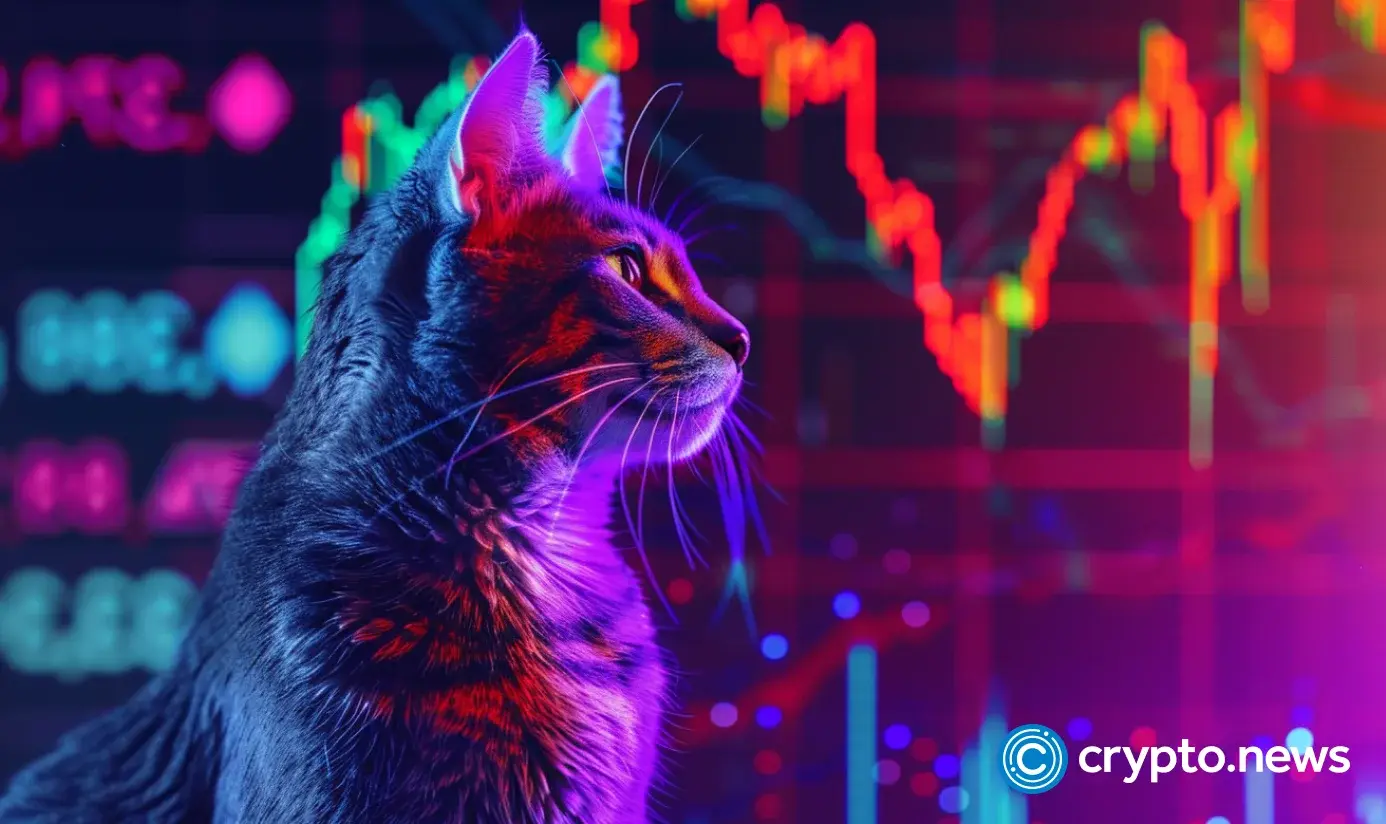
In just 10 days, POPCAT has dropped over 30%, but the decline may not be over. A deeper analysis of multiple indicators reveals that further declines could be on the horizon.
Inside POPCAT’s parallel channel
POPCAT respects a parallel channel that defines its movement. While there have been moments when the price broke above or below the channel, it continues to adhere to this pattern over time. The white lines on the chart offer a simplified representation of the price movements within the channel.

Looking ahead, the yellow lines depict a possible future path for POPCAT. The next move could see a drop to around $0.43 in the coming weeks, representing a further decline of over 23% from the current level. After this, the price may then rally towards $0.87 around October to November.
Gartley harmonic pattern on the verge of completion
One strong indication that supports the likelihood of a further downturn in POPCAT is the development of the Gartley harmonic pattern on its daily chart. The Gartley pattern is a type of harmonic price formation that signals potential reversal zones based on Fibonacci ratios and has an 85% success rate. It consists of five points—X, A, B, C, and D—and represents a retracement followed by a continuation of the overall trend.
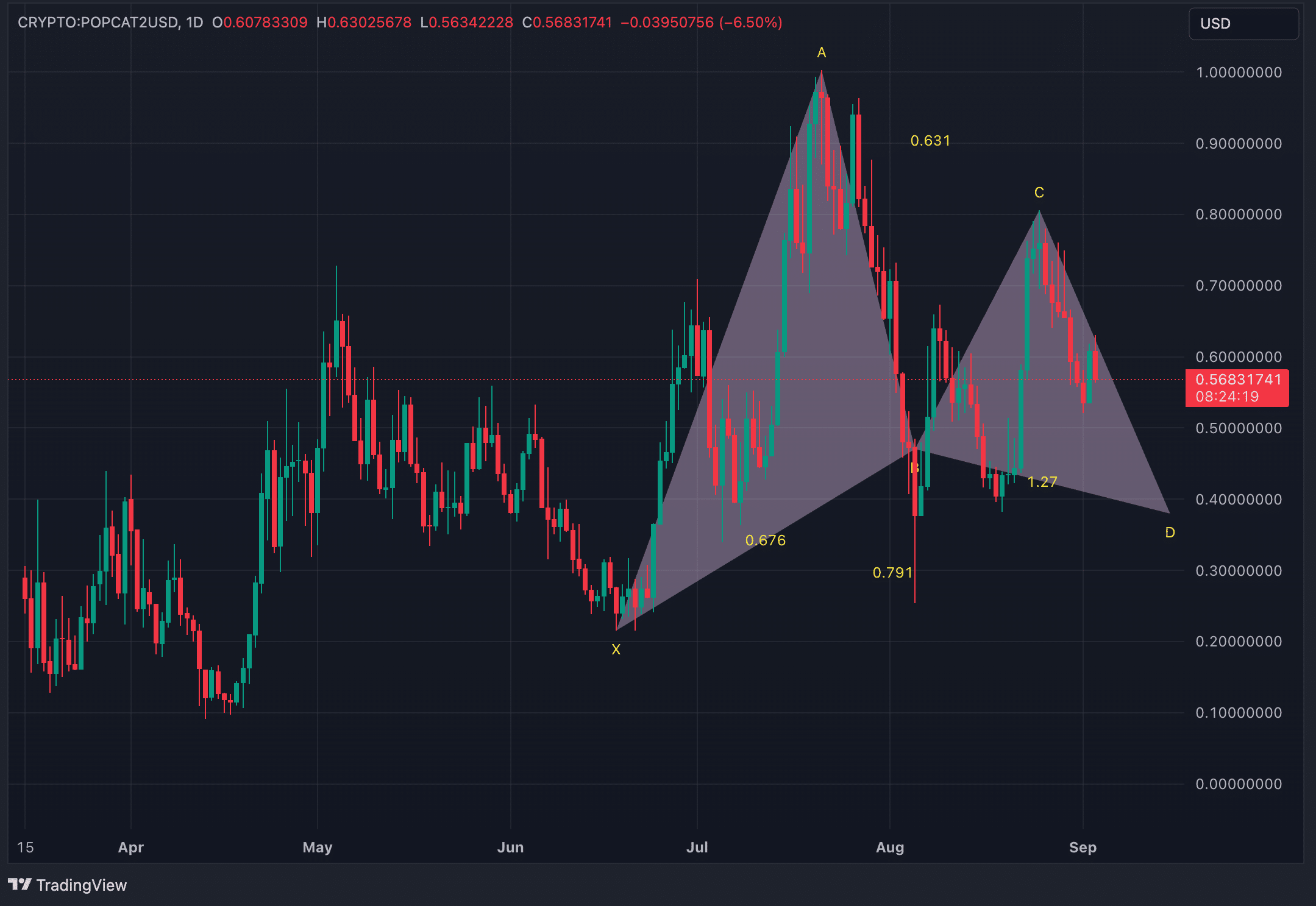
In the case of POPCAT, the pattern has formed with the final point D yet to be completed. If the Gartley pattern completes as expected, the price could drop to approximately $0.38. This target lies slightly below the lower boundary of the established parallel channel.
MACD Reversal
Another factor pointing toward a potential continued decline in POPCAT is the recent bearish crossover in the Moving Average Convergence Divergence (MACD) indicator. The MACD is a momentum indicator that consists of two lines: the MACD line and the signal line. It shows the strength and direction of a trend by analyzing the relationship between these two lines.

A crossover occurs when the MACD line crosses below the signal line, which is seen as a bearish signal, similar to a “death cross” in moving averages. The crossover means that the momentum has shifted from bullish to bearish.
Counterpoints: Limited downturn possibility
While several factors suggest a continued downturn for POPCAT, there are also indicators that could limit or even conclude the current decline.
First, there is a confluence of multiple Fibonacci golden pockets in the $0.53 to $0.593 range. These include the Fibonacci retracement from the low on August 19 to the high on August 25, the high on July 1 to the low on August 5, and the low on July 5 to the high on July 21. Additionally, the 50% retracement levels from other Fibonaccis also converge within this price zone, which strengthens the support in this area. Until POPCAT drops below $0.53, the downward movement will likely not continue. On the other hand, if it fails to break above $0.593, we also cannot confirm that the decline has ended.
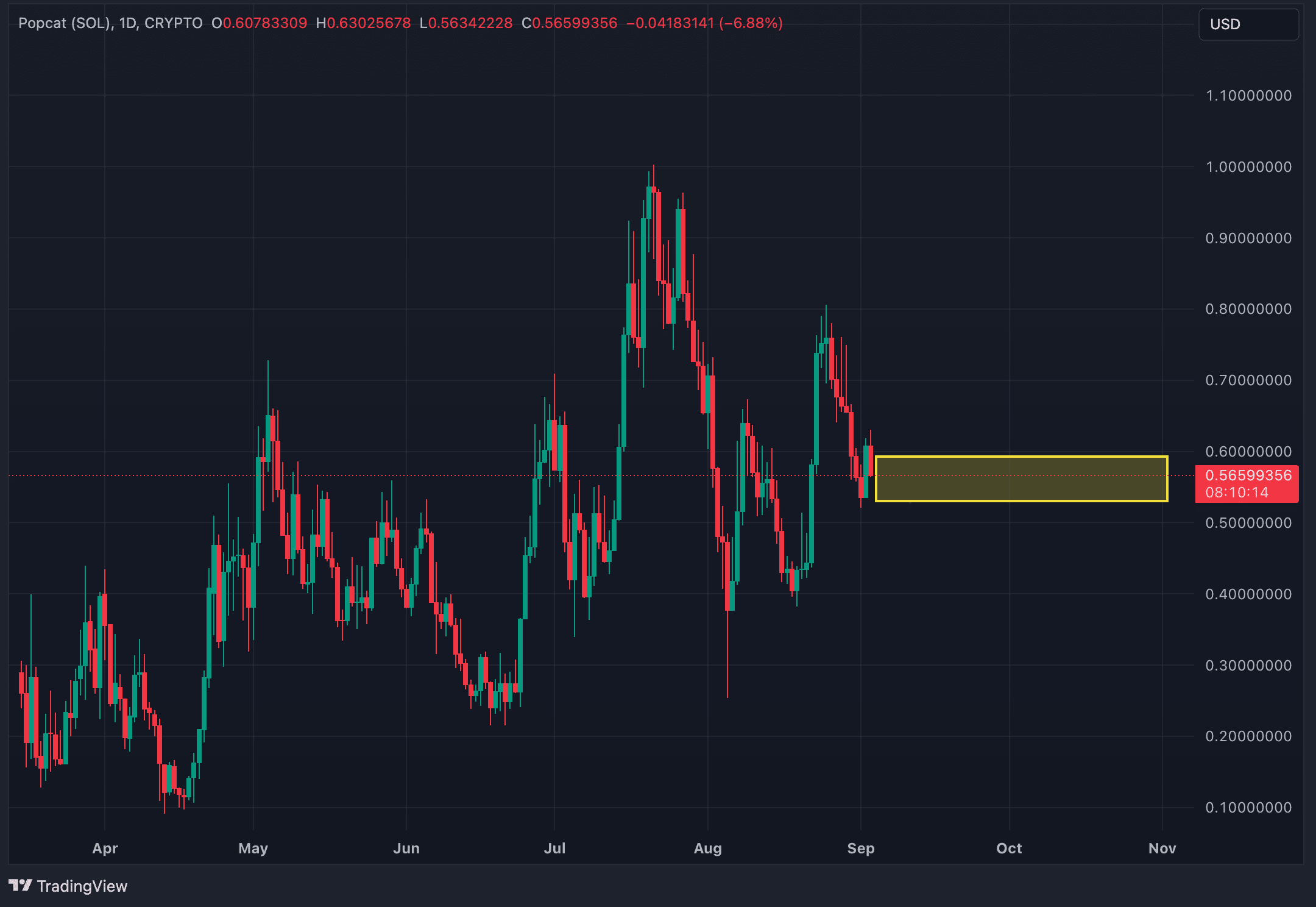
Adding to this, the historical volatility range for POPCAT between $0.50 and $0.55 has been quite an important zone, acting as support or resistance on 38 different occasions. The area closely aligns with the golden pocket confluence, which further reinforces the significance of this zone as a potential floor for the current downtrend.
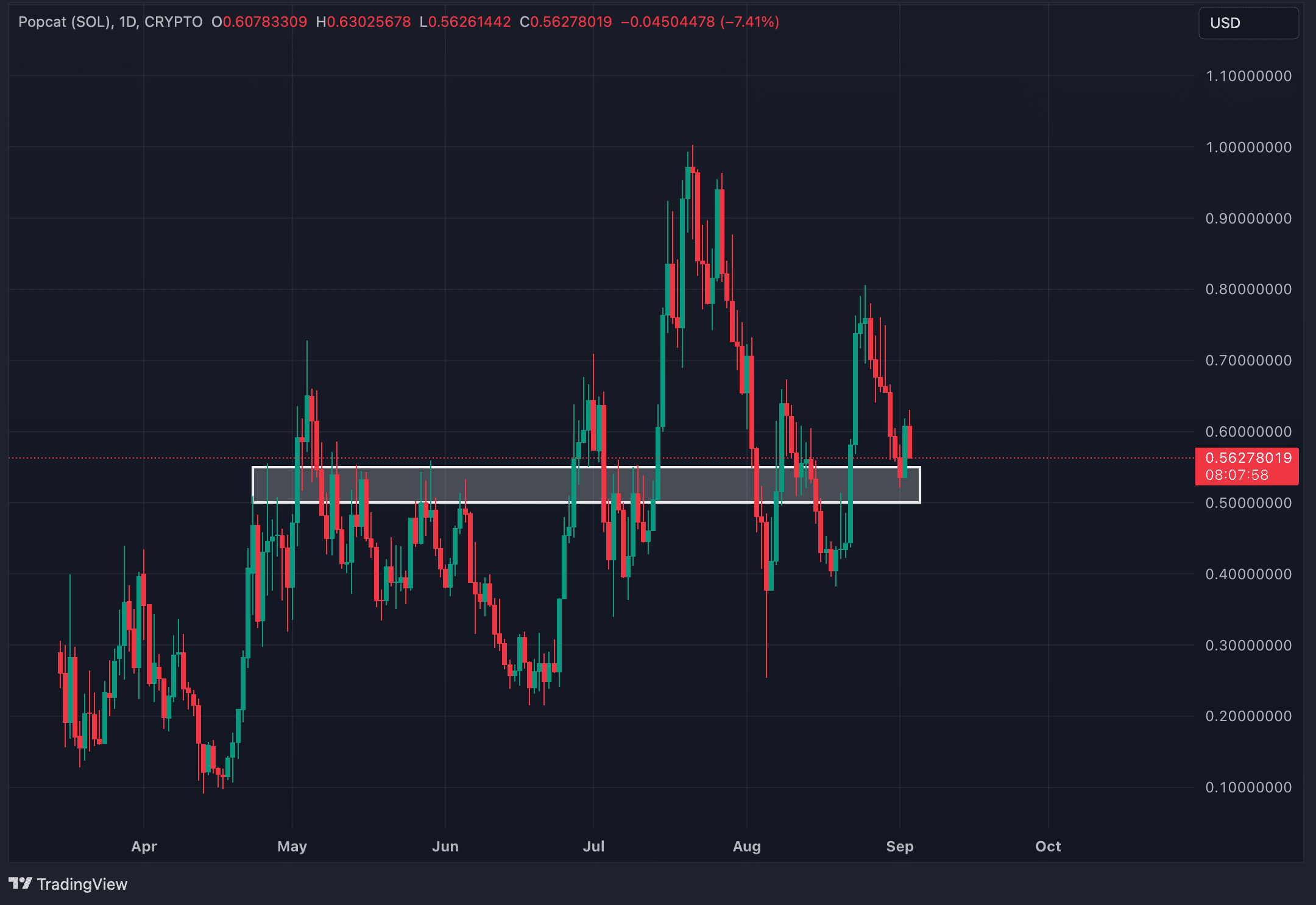
Lastly, the Visible Range Volume Profile (VRVP) adds another layer of support in the $0.55 to $0.593 area. The VRVP is a tool that displays trading activity at various price levels and highlights areas with high trading volumes as major zones of support or resistance. In this case, the volume bar in the $0.55 to $0.593 range is the biggest and suggests strong buyer interest. However, if POPCAT drops below $0.40, the volume profile thins out considerably, indicating little to no support below that level, which could lead to even steeper declines if breached.
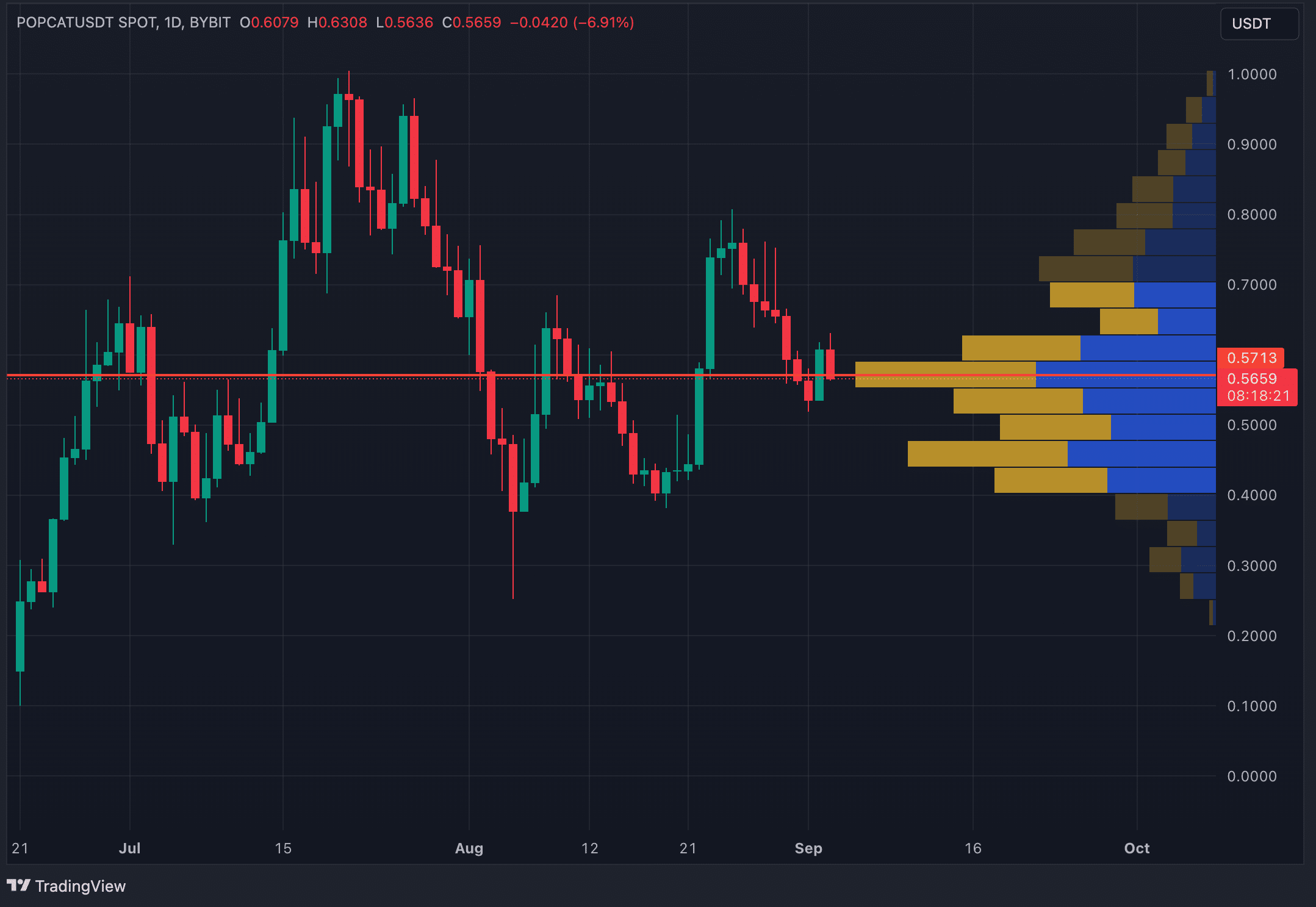
Strategic considerations
At the current price level, POPCAT presents a conundrum. On the one hand, several indicators suggest further downturns, while on the other, key support levels hint that the bearish phase may have already run its course, with bullish momentum potentially on the horizon.
In our analysis, which aligns with insights shared in previous articles, the upcoming monetary policy shift—specifically the anticipated rate cuts in September—combined with the historically weak performance of cryptocurrencies in September could render these support zones for POPCAT obsolete. Given this outlook, the strategic approach would involve shorting POPCAT down to the $0.43 level.
Disclosure: This article does not represent investment advice. The content and materials featured on this page are for educational purposes only.
Source link
You may like


Here’s why Stellar Price Could Go Parabolic Soon
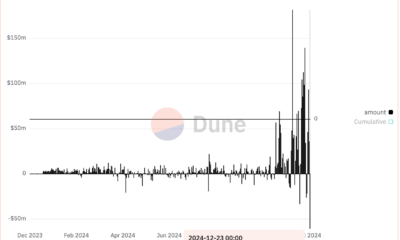

Perp-Focused HyperLiquid Experiences Record $60M in USDC Net Outflows


Experts say these 3 altcoins will rally 3,000% soon, and XRP isn’t one of them


Robert Kiyosaki Hints At Economic Depression Ahead, What It Means For BTC?


BNB Steadies Above Support: Will Bullish Momentum Return?


Metaplanet makes largest Bitcoin bet, acquires nearly 620 BTC
crypto traders
Crypto giants Arca and BlockTower merge into one crypto management leader
Published
1 month agoon
November 13, 2024By
admin

Arca and BlockTower, two leading firms in digital asset management, announced their plans to merge in an all-equity deal.
Per a joint press release, the merger will create a combined entity that delivers regulated, institutional-grade crypto investment products to a growing market. The two firms have signed a Letter of Intent and plan to consolidate their operations under one brand.
BlockTower’s venture capital unit will remain independent.
The merger addresses the increasing demand for digital assets within a regulated investment environment. Rayne Steinberg, CEO at Arca, noted via the press release that uniting the firms will enable them to provide products that adhere to regulatory standards, a priority for investors seeking more secure ways to access digital assets.
Financial institutions are embracing crypto
Digital asset management involves overseeing investments in cryptocurrencies and blockchain-related assets, offering opportunities for both individual and institutional investors to explore this emerging sector.
Companies like Arca and BlockTower offer specialized funds in this area, managed by people with solid Wall Street backgrounds.
By teaming up and pooling their resources, these firms aim to create stronger products and navigate the ever-evolving world of crypto with confidence.
“Competing in the maturing digital assets space and serving our investors requires a constant fight for top talent. By merging with Arca, we’re excited to create a stronger investment team immediately.”
Ari Paul, Co-Founder and Chief Investment Officer at BlockTower
Once the merger is finalized, the unified firm will focus on delivering investment options that blend the growth potential of digital assets with the security of institutional-grade standards.
Source link
Binance
POPCAT, DOGS soar as Bitcoin reclaims $56k
Published
3 months agoon
September 9, 2024By
admin

Popcat and Dogs are the two top-gaining tokens in the 100 largest cryptocurrencies by market cap as Bitcoin price climbs back above $56,000.
The meme coins Popcat (POPCAT) and Dogs (DOGS) traded at $0.62 and $0.0011, with 19% and 16% in 24-hour gains respectively at the time of writing. Upside momentum meanwhile had pushed Bitcoin (BTC) price above $56,500 as bulls fought to recover from the dip that saw the leading digital asset trade near $53,300 on Sept. 7.
Futures listing helps POPCAT, DOGS higher
Most meme coins have struggled for upward momentum in recent weeks, mainly as the broader market experienced downward pressure throughout August.
However, like many other small cap tokens, Solana(SOL)-based Popcat and Telegram-related Dogs have benefited from a rush of positive sentiment following crucial futures trading support across major exchanges..
Binance recently added POPCAT perpetual contracts, allowing traders to bet on the meme coin’s price. This move caused Popcat’s price to spike significantly. OKX also added POPCAT futures and outlined a trading contest that offers up to $100 in rewards.
DOGS, which slipped amid the recent arrest of Telegram CEO Pavel Durov, has recovered some of the losses since falling to $0.0009 on Sept. 8. Previously, the Telegram-native meme coin had rallied thanks to Binance’s offering of 40 million DOGS in a contest that ends on Sept. 17.
Binance, OKX, and Bybit are some of the top exchanges supporting the DOGS airdrop and token listing.
Bitcoin recovers above $56k
Bitcoin’s recovery to above $56,500 comes amid a bounce in the Coinbase Premium Index, a metric indicating increased whale and institutional accumulation of BTC.
A rebound in U.S. demand may help bulls reposition for a stronger end to the fourth quarter. Analysts at CryptoQuant see the continued accumulation by long-term holders as key to a potential price bounce.
Bernstein analysts issued a note on Sept. 9 predicting a surge to $80k-$90k for BTC if Donald Trump wins the U.S. presidential election.
However, they suggested that a win for Kamala Harris could trigger downside action, potentially pushing BTC to lows of $30,000. The contrast is rooted in the crypto industry’s perception of Trump as more crypto-friendly compared to Harris.
Source link
Cardano
Last Fed rate cut sent Cardano crashing 57% – what about now?
Published
4 months agoon
September 6, 2024By
admin
Cardano dropped 57% when the Federal Reserve cut rates back in 2019. With another rate cut on the horizon, the cryptocurrency faces a similar setup that could bring major downside.
Cardano prepares for September decline
In May 2019, the Federal Reserve initiated its first rate cut, lowering rates from 2.42% to 2.39%. Rates at that time were much lower than today, and the public debt stood at $22 trillion. Today, debt has increased to nearly $35 trillion, and interest rates now stand at 5.33%, more than double the 2019 levels.

When the rates started to fall in 2019, Cardano experienced a sudden drop. After a brief period of recovery, the downtrend continued for months until early 2020. An uptrend emerged later, but the market downturn during the COVID-19 pandemic coincided with further rate cuts. Despite uncertainties around the exact link between rate cuts and crypto declines, Cardano and the broader market saw a clear decrease in value.
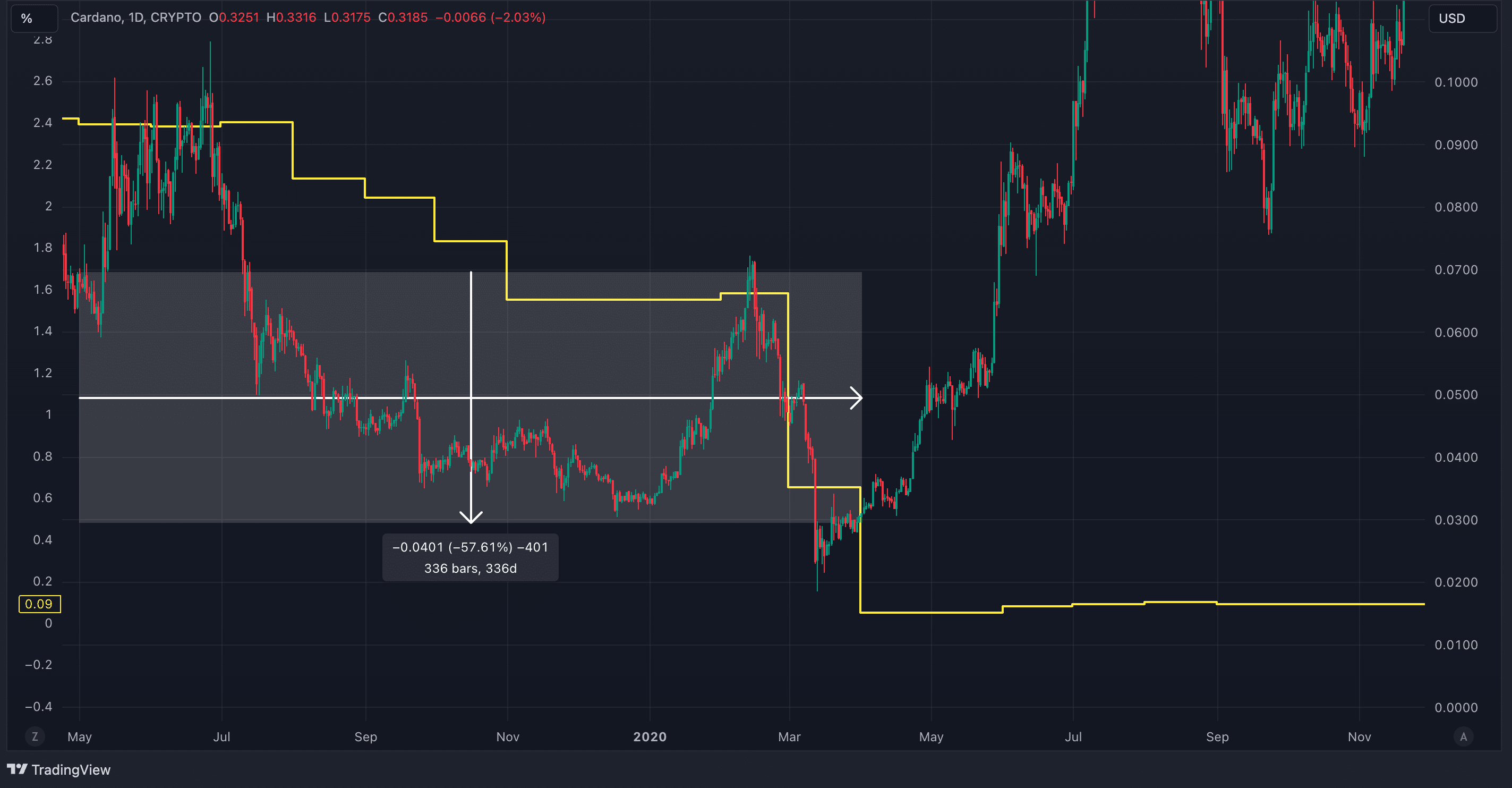
A similar scenario could unfold today. Crypto has shown correlations with traditional finance in the past, including during the 2019 rate cut. The Federal Reserve’s upcoming meeting is likely to result in a rate cut based on CME data. If the market follows the 2019 pattern, Cardano could face a multi-month decline, which could last until the end of the year, before recovering in early 2025. A repeat of the previous trend could push Cardano’s price down to around $0.15.
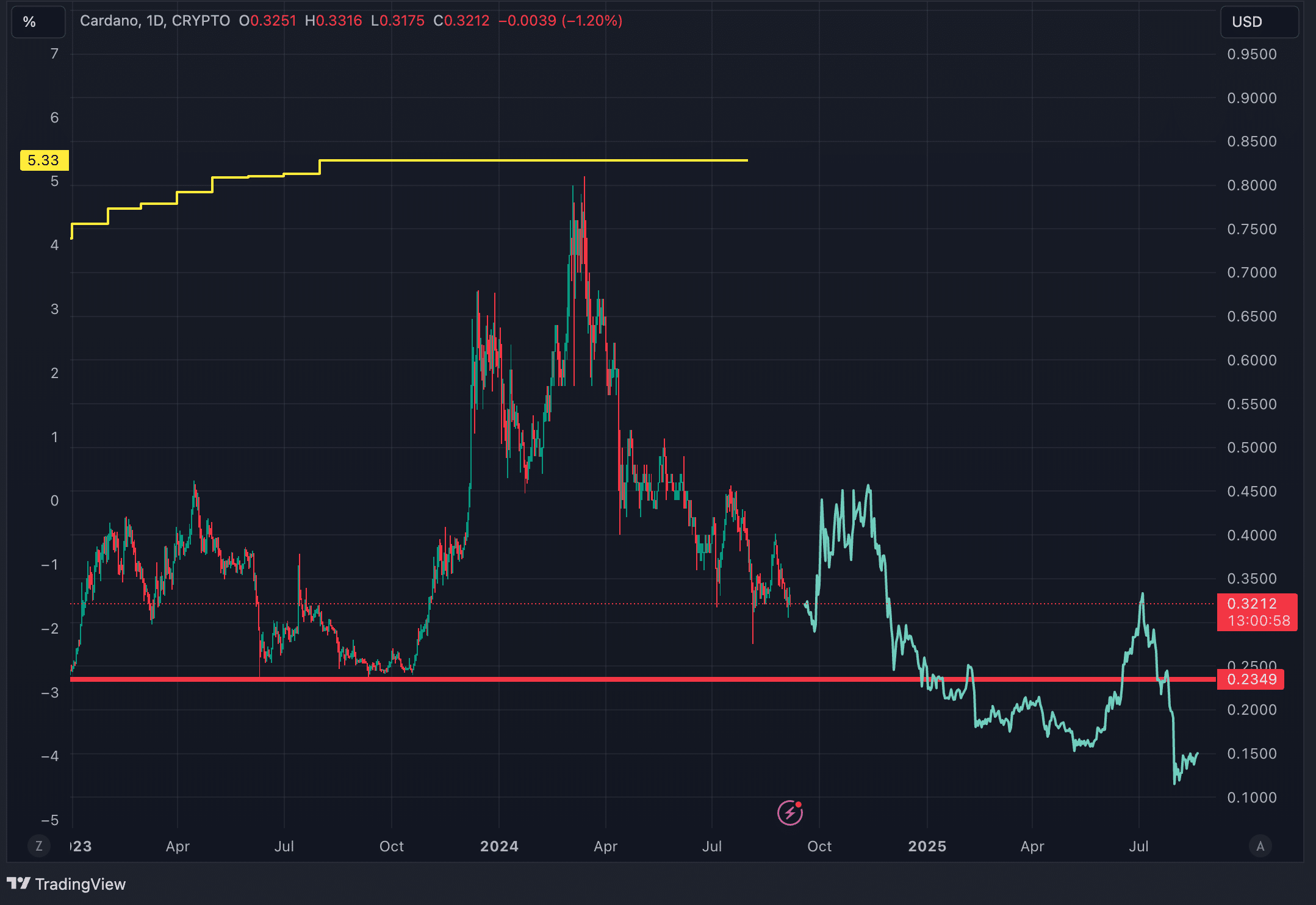
Additionally, September has often proven to be a tough month for both stocks and crypto. In September 2020, during a halving year, Cardano also faced a downtrend. Coupled with the current 10% drop since the start of this month, these factors could drive Cardano toward a deeper fall in the weeks and months ahead below its 2022 support line at $0.2349.
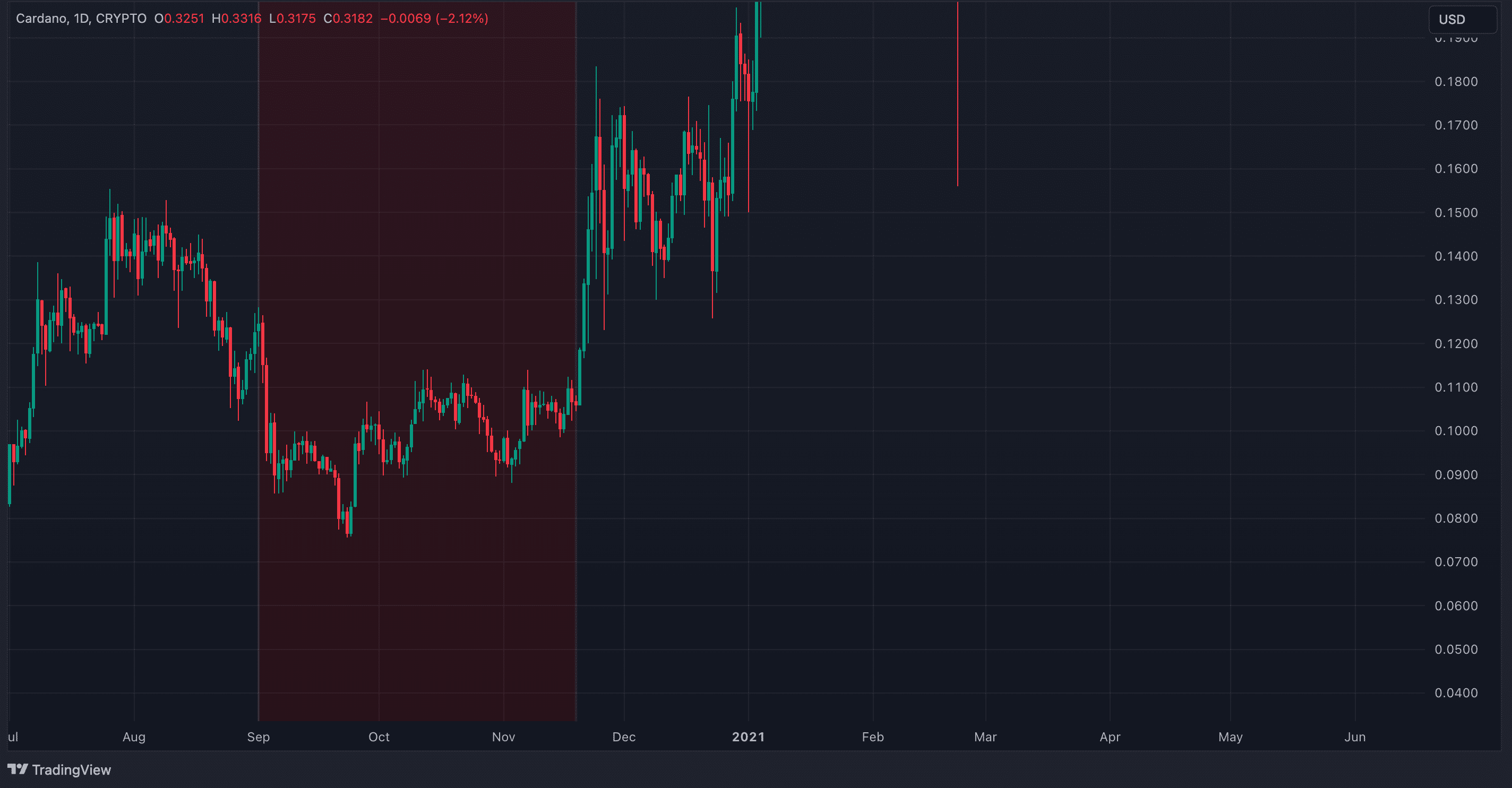
Cardano’s bearish momentum grows with SRSI, MACD, and VRVP
Many traders focus on short-term movements, but stepping back for a longer-term view can give a better sense of the bigger picture. Cardano’s monthly Stochastic RSI (SRSI) and MACD are flashing warning signs that shouldn’t be ignored, and both are painting a rough picture for ADA.
The SRSI tracks momentum by looking at an asset’s price range over time. The scale goes from 0 to 100, with anything below 20 showing oversold conditions. Since March 2024, the SRSI has been sliding, and it’s now closing in on that oversold region.

The MACD, meanwhile, is showing similar bearish vibes. On the monthly chart, the MACD line has already crossed below the signal line, which is a sign of downward pressure. The histogram, which shows the gap between the two lines, is about to flip red, also pointing to a growing bearish momentum.
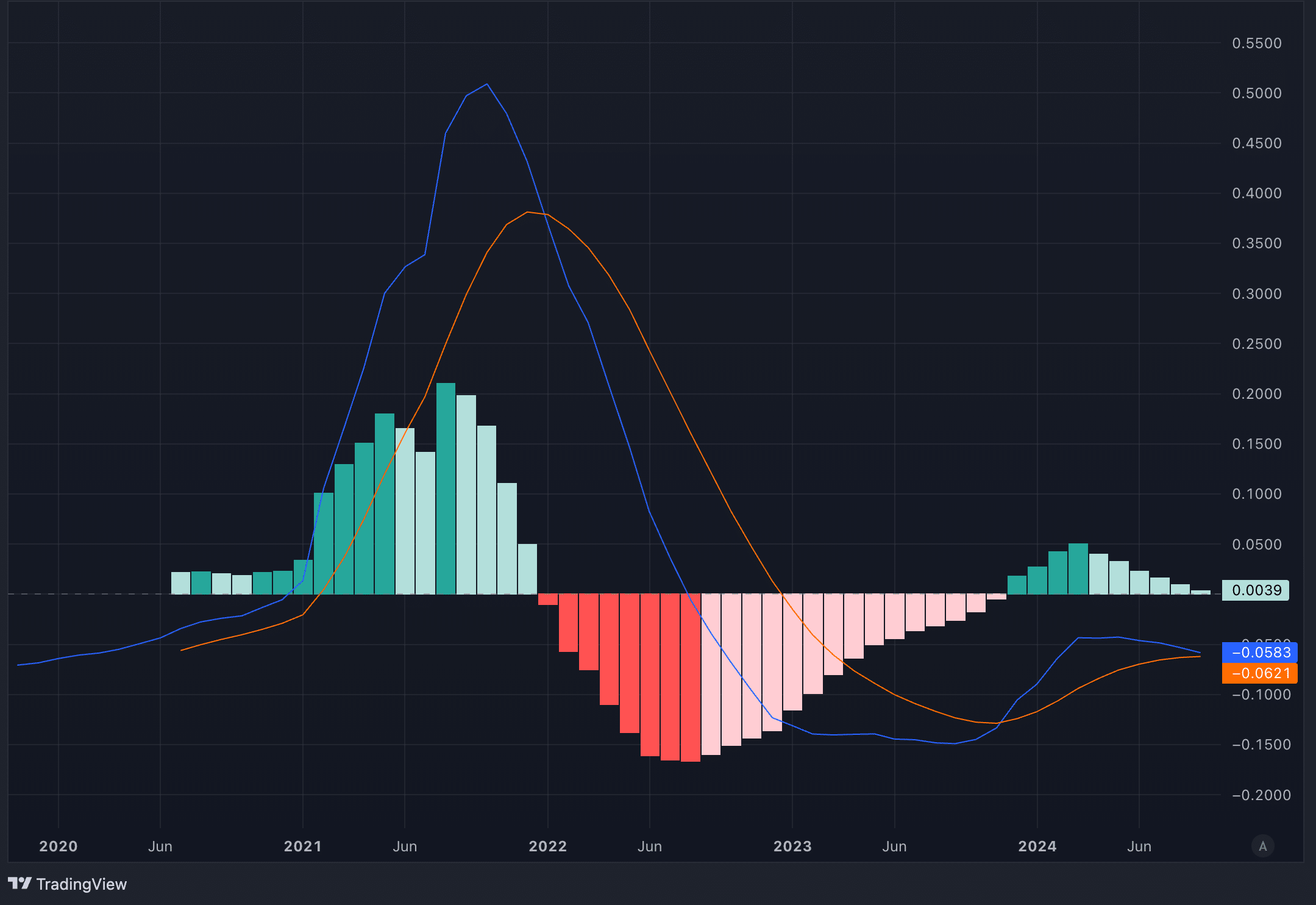
Alongside the bearish signals from the Stochastic RSI and MACD, the Visible Range Volume Profile (VRVP) adds even more negative pressure to the outlook. The VRVP shows where most trading volumes occurred at various price levels. In Cardano’s case, the volume bars within the current price range are quite thin, which indicates weak support. The biggest volume bar begins at the $0.15 level, suggesting a strong support zone there. Below the current price, there’s a gap in the volume profile, which means if Cardano continues to fall, there’s little trading activity to slow down the drop until it reaches that $0.15 zone.
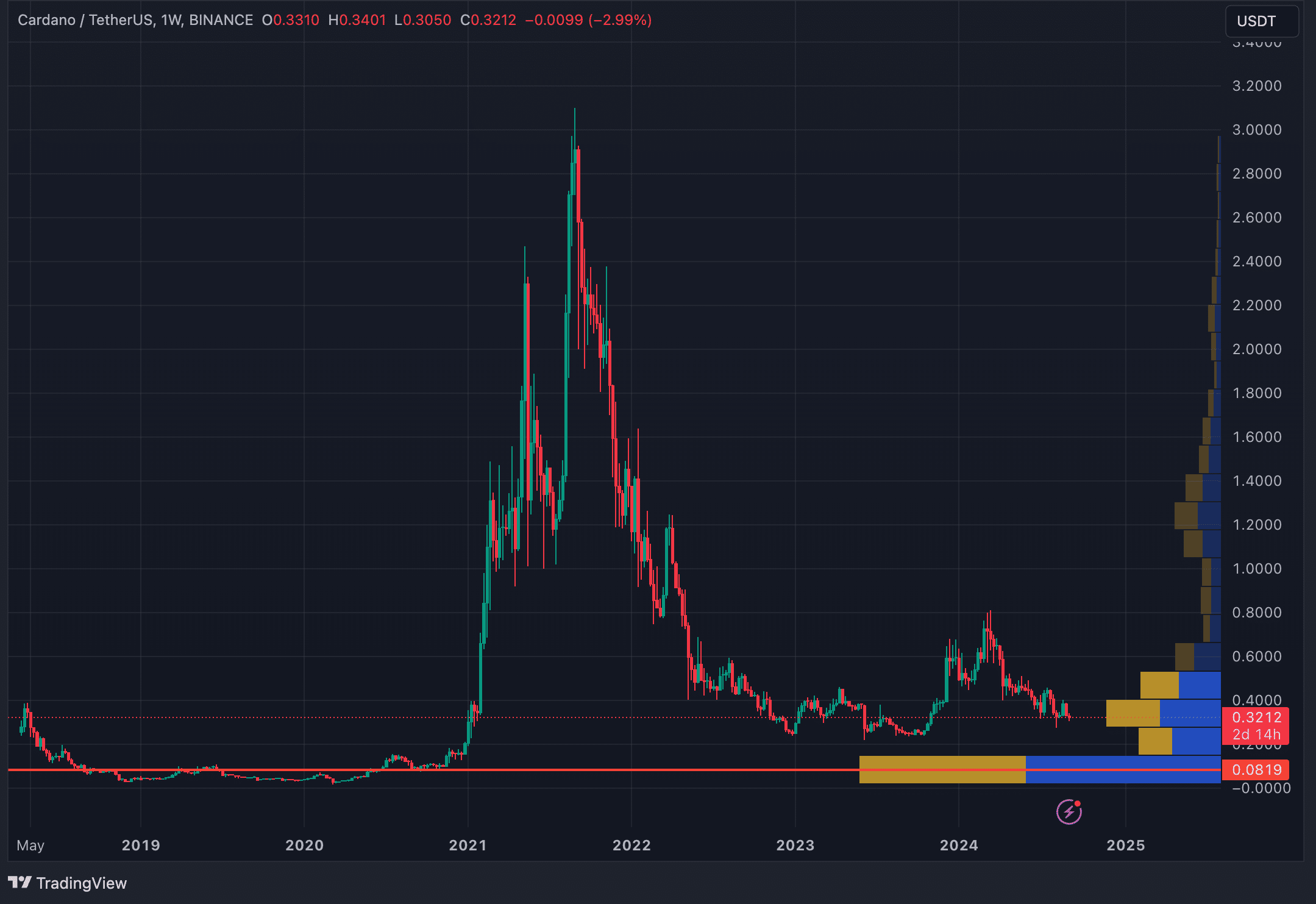
Is Cardano’s 2022 support line strong enough to hold?
Despite the bearish indicators, a couple of factors could prevent Cardano from dropping sharply. At the moment, the price sits within a macro Fibonacci golden pocket, drawn from the all-time low to the recent high in March 2024. This zone, between $0.2951 and $0.3204, has acted as support for now. However, when looking at other Fibonacci retracements from different points, ADA has already fallen below the 78.6% retracement on every one of them. This could raise doubts about the strength of the current golden pocket, as there’s a possibility it may not hold up in the long term.

A stronger support level, however, lies at $0.2349, a line that was respected during the 2022 bear market. But, with ADA currently around $0.315, a drop to that support would still represent a 25% decline, which would be far from ideal.
Strategic considerations
In our view, there could be a dead cat bounce before the September 18 Fed meeting. However, after that, ADA is likely to face a 2-3 month downtrend until the Fed slows the pace of its rate cuts. A more cautious strategy would be to wait for ADA to drop below the $0.2951 golden pocket before shorting. This offers a safer entry point compared to shorting immediately right now, as Cardano could see a short-term uptrend while holding above the golden pocket. If the price falls below this level, shorting down to $0.2349 becomes a more calculated move.
Disclosure: This article does not represent investment advice. The content and materials featured on this page are for educational purposes only.
Source link

Here’s why Stellar Price Could Go Parabolic Soon

Perp-Focused HyperLiquid Experiences Record $60M in USDC Net Outflows

Experts say these 3 altcoins will rally 3,000% soon, and XRP isn’t one of them

Robert Kiyosaki Hints At Economic Depression Ahead, What It Means For BTC?

BNB Steadies Above Support: Will Bullish Momentum Return?

Metaplanet makes largest Bitcoin bet, acquires nearly 620 BTC

Tron’s Justin Sun Offloads 50% ETH Holdings, Ethereum Price Crash Imminent?

Investors bet on this $0.0013 token destined to leave Cardano and Shiba Inu behind

End of Altcoin Season? Glassnode Co-Founders Warn Alts in Danger of Lagging Behind After Last Week’s Correction

Can Pi Network Price Triple Before 2024 Ends?

XRP’s $5, $10 goals are trending, but this altcoin with 7,400% potential takes the spotlight

CryptoQuant Hails Binance Reserve Amid High Leverage Trading

Trump Picks Bo Hines to Lead Presidential Crypto Council

The introduction of Hydra could see Cardano surpass Ethereum with 100,000 TPS

Top 4 Altcoins to Hold Before 2025 Alt Season
182267361726451435

Why Did Trump Change His Mind on Bitcoin?

Top Crypto News Headlines of The Week

New U.S. president must bring clarity to crypto regulation, analyst says

Will XRP Price Defend $0.5 Support If SEC Decides to Appeal?

Bitcoin Open-Source Development Takes The Stage In Nashville

Ethereum, Solana touch key levels as Bitcoin spikes

Bitcoin 20% Surge In 3 Weeks Teases Record-Breaking Potential

Ethereum Crash A Buying Opportunity? This Whale Thinks So

Shiba Inu Price Slips 4% as 3500% Burn Rate Surge Fails to Halt Correction

Washington financial watchdog warns of scam involving fake crypto ‘professors’

‘Hamster Kombat’ Airdrop Delayed as Pre-Market Trading for Telegram Game Expands

Citigroup Executive Steps Down To Explore Crypto
Mostbet Güvenilir Mi – Casino Bonus 2024

NoOnes Bitcoin Philosophy: Everyone Eats
Trending

 3 months ago
3 months ago182267361726451435

 Donald Trump5 months ago
Donald Trump5 months agoWhy Did Trump Change His Mind on Bitcoin?

 24/7 Cryptocurrency News4 months ago
24/7 Cryptocurrency News4 months agoTop Crypto News Headlines of The Week

 News4 months ago
News4 months agoNew U.S. president must bring clarity to crypto regulation, analyst says

 Price analysis4 months ago
Price analysis4 months agoWill XRP Price Defend $0.5 Support If SEC Decides to Appeal?

 Opinion5 months ago
Opinion5 months agoBitcoin Open-Source Development Takes The Stage In Nashville

 Bitcoin5 months ago
Bitcoin5 months agoEthereum, Solana touch key levels as Bitcoin spikes

 Bitcoin5 months ago
Bitcoin5 months agoBitcoin 20% Surge In 3 Weeks Teases Record-Breaking Potential


